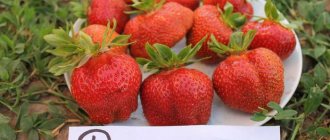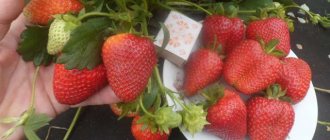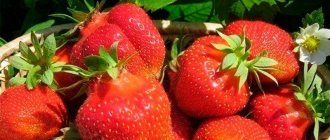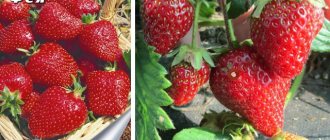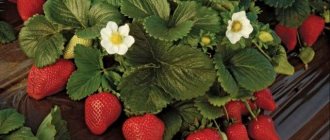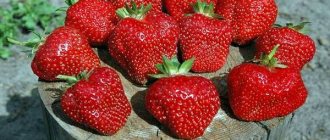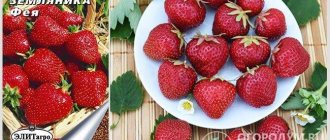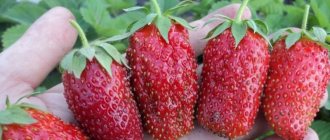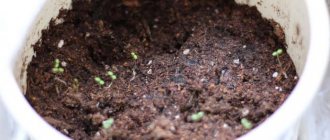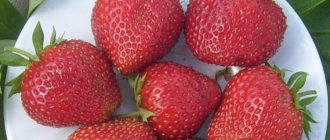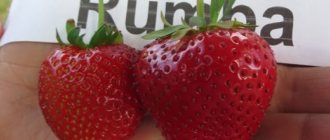The Irma variety was bred back in 1995 by Italian breeders from the homeland of Romeo and Juliet - Verona. However, a patent for the first sample of the crop was received only in 2003. This variety of strawberry with excellent taste was bred specifically for the highlands of Northern Italy. Although it has been adapted to hot climates, its full potential is best achieved in mild-temperate climates with sufficient rainfall.
Description of the variety Irma
Day neutral strawberries.
Sweet taste with a slight sourness.
Stable harvest throughout the second half of summer.
Dessert variety of strawberries.
Powerful and compact bush.
The key feature for which gardeners and farmers value the Irma variety so much is its high yield combined with excellent tasting qualities.
The productivity of a crop can be classified as a commercial indicator, it is so high. The first period of fruiting of Irma strawberries corresponds to mid-early varieties.
Fruit
- The fruits are large, weighing about 25–30 grams, cone-shaped with dense pulp and a bright red glossy color.
- The taste is sweet and at the same time very multifaceted. There is a delicate, unobtrusive sourness, which makes the variety dessert.
- The aroma is moderate; there are also more strawberry-flavored varieties.
- The impressive sugar content of the variety does not depend on rain; even a season of high humidity does not affect the taste of the berry.
The end of the fruiting season is marked by a decrease in the size of the fruits and a slight change in their shape . The largest harvest is harvested in late August-early September, however, the most delicious berries are the first.
Bushes
Bushes of medium height with powerful roots and large dark green leaves.
- The bushes of the Irma variety themselves are powerful, compact with medium foliage.
- The peduncles are quite tall and long.
- The culture's adaptation is good.
- But the variety is also resistant to most fungal diseases, gray rot, and pests.
Peculiarities
The Irma variety is a day-neutral variety.
Strawberries "Irma" begin to bear fruit in mid-June.
And like many of them, the peak of fruiting occurs in the second year. After this, productivity gradually decreases. In the third year, it is advisable to begin updating the plantings . To do this, you can use your own planting material.
general characteristics
The Irma strawberry variety is considered remontant, that is, the bushes bear fruit throughout the season.
Usually this happens 3-4 times. The first fruits ripen by the end of May. The berries have an elongated shape, resembling a cone, and are bright red in color. The weight of the berry can reach up to 60 grams. The taste of the berries is brighter in summer and autumn than in spring. The berries are juicy with tender pulp and have a high sugar content.
The bushes of the variety are medium in height, with strong root structures, large leaves of dark green color. There are not too many whiskers, but the flower stalks are developing well.
The variety is characterized by a high level of productivity and excellent resistance to winter frosts. One bush produces 1-2 kg of berries, and with careful care this figure increases to 2.5 kg. Thus, “Irma” (strawberry, the description of which is the subject of our attention) is a fairly high-yielding crop.
Advantages
The Irma variety is so popular among our and European gardeners due to a number of undeniable advantages, such as:
- excellent taste;
- good density and, accordingly, keeping quality of the fruit;
- the berries are practically not baked in the sun;
- good transportability;
- high productivity;
- drought resistance.
The variety provides a high yield of berries with sufficient watering.
Drip irrigation solves all watering problems; slight shading in intense heat guarantees constant wave-like fruiting of the crop and delicious sweet berries on your table throughout the season.
Flaws
Among the disadvantages, it is worth mentioning that during periods of intense heat, the yield decreases slightly (compared to other varieties, where it tends to almost zero). Since any variety of strawberry appreciates watering, it is better not to forget about the latter.
Growing
The Irma variety gives a particularly good and generous harvest of berries in the second year of growth. And then the strawberry yield declines. For household plots and summer cottages, yields in the third and fourth years are acceptable, provided timely fertilizing is done. Then the plantings of remontant strawberries are changed. Reviews from those who grew Irma strawberries indicate the ability of strawberries to easily propagate by tendrils. This method is easier and more familiar.
Reproduction by mustache
The strawberry variety is easy to propagate as it produces enough runners.
- Gardeners, according to reviews of Irma strawberries and the description of the variety, choose which plants they leave for picking berries and remove the tendrils from them;
- Others grow into future seedlings. But on these bushes the flower stalks are already removed so that the plant can feed the cuttings;
- It is better to root only the first two rosettes;
- The tendrils are left on biennial plants and the plantation is renewed for commercial purposes for the next season.
Warning! Remontant strawberries are characterized by rapid degeneration, since the bush devotes a lot of energy to abundant wave-like fruiting.
Propagation by seeds
The method of growing the Irma strawberry variety from seeds through seedlings, according to reviews from lovers of the sweet berry, is more complex and labor-intensive. But the troublesome process ensures the purity of the variety.
- Sow Irma strawberry seeds in February or early spring in containers with soil for vegetable seedlings, covering the top with a thin layer of soil;
- The containers are covered with film or glass, but ventilated and watered daily if the soil is dry;
- It is necessary to adhere to the optimal temperature - from 18 0C;
- Shoots appear after three weeks. They require maximum lighting;
- The seedlings are moved to a permanent place when 5 leaves are formed on it.
Important! Strawberries are planted so that the rosette is above the ground.
Site selection
Planting and caring for remontant Irma strawberries, as experience shows, will be successful if the appropriate site is selected: sunny, rich in nutrients. If possible, the ideal area for planting this variety may have a slight slope to the southwest.
- Clay and sandy soils should be avoided for planting the Irma variety;
- Soils with very high or too low acidity levels are also undesirable;
- Strawberries grow well in areas where there used to be radishes, garlic, legumes, forage or green crops;
- Humus and compost are added to the soil;
- The addition of peat is also accompanied by 200-300 g of lime or dolomite flour;
- Mineral fertilizers include superphosphate and potassium chloride.
Landing
Strawberries are planted in spring or autumn. But late autumn planting entails low productivity of the first fruiting season.
- The width between double-row strawberry ribbons is 60-80 cm;
- Inside, between the rows, a distance of 35-40 cm is enough;
- The holes are made at a distance of 15-25 cm. They must be dug to a depth of 10-12 cm in order to freely accommodate the roots of the plant;
- For planting, prepared soil is poured into the holes: 1 bucket each of site soil and compost, 2 liters of humus, 0.5 liters of wood ash.
Care
Caring for strawberries is not difficult, but the culture requires attention.
- Regular watering is needed, especially in hot July. Then the soil is slightly loosened, weeds are removed and covered with a layer of mulch;
- In the first year of planting, for a better harvest, the peduncles of the first wave are removed, as well as all the tendrils;
- It is necessary to periodically pick off reddened leaves;
- Strawberry leaves are sprinkled with wood ash. The product serves as a top dressing and protects plants from pests;
- If the berries are still ripening in October, the plants are covered with film or agrofibre;
- In late autumn, the mustache and damaged leaves are trimmed. Humus or peat is placed on the soil and covered with snow in winter;
- In the spring, during flowering and the creation of ovaries, mineral complex fertilizers are applied.
This universal variety with sweet berries will appeal to connoisseurs of fresh homemade produce.
Selecting a planting site and optimizing the soil
They say that marigolds repel nematodes from strawberries.
When choosing a planting site, you should remember that the crop feels worst on sandy and clay soil. But it is also not recommended to plant plants in alkaline and acidic soil, or light gray soil . In such places there are insufficient nutrients necessary for normal growth and development. This type of soil retains moisture and can cause root rot.
The ideal place for future strawberry plantations will be former plantings of legumes, mustard, lettuce, garlic, radishes and herbs.
We have collected early garlic - we dig up the bed and plant strawberries.
The selected area for planting should be flat, with a slight slope towards the southwest. In this case, the necessary moisture and warming are provided to him.
- One of the best soil options is humus . Such soil is rich in organic matter, which contains many nutrients for strawberry crops. You can form this type of soil yourself, because it consists of humus and the remains of vegetation that have gone through the stage of decomposition.
- Peat soil is a subject of debate among many experienced farmers. Some of them believe that it has a positive effect on crop growth, others talk about its increased acidity. Therefore, in addition to peat, sawdust, dolomite flour or lime are additionally added to the soil, which reduce the acidity of the soil.
Soil preparation
Preparing the site for planting includes careful digging, which is more efficient to do with a pitchfork rather than a shovel.
The area for strawberries is dug up a month before planting.
After removing weeds, roots, stones and other debris, organic matter is added - compost or manure . In some cases, it is necessary to add potassium chloride and superphosphate.
Formation of beds
After all the procedures, you can begin to form future beds.
They should not be wider than 60–80 cm and arranged in several parallel rows.
After formation, the soil in the beds should be periodically moistened without flooding. Excess moisture will not benefit future plantings.
Planting work
When planting Irma strawberries (the description of the variety, photos, reviews about it are the topic of the article), you should listen to the following tips:
- The soil is prepared in advance. Lupine, clover, rapeseed, and legumes are considered successful predecessors. After them, the earth is saturated with nitrogen.
- Before planting, the soil is loosened and all weeds are removed.
- Organic matter is added to each hole. Nutritious soil is prepared from 10 kg of soil, 10 kg of compost mixture, 2 liters of vermicompost and 400 grams of ash.
- The optimal width of the bed is one meter; bushes are planted at intervals of 0.5 meters.
- When planting, the roots are directed vertically.
- After planting, the plants are well watered and covered with mulch. Sawdust, pine needles, and grass are suitable for this purpose.
Landing
The bushes of the Irma variety are powerful, but not spreading, so in their case the classic type of planting is acceptable.
When planting seedlings, it is necessary to maintain the recommended intervals between individual bushes and between rows.
With the two-line method, bushes are planted at a distance of 15–25 cm with a distance of 35–40 cm between rows. This method is more practical in small garden plots.
Planting can be carried out both in spring and at the end of August-early September . In the southern regions this period can extend until the end of October. However, it should be remembered that the later planting is carried out, the less productivity will be next year.
Plants are planted in small holes 10–12 cm deep, dug in and moistened. It must be remembered that the rosette of the plant must be at the level of the top layer of soil. Watering is done with warm water.
The “heart” of the seedling is placed flush with the soil surface.
Reproduction and care
As for propagation, the Irma variety is known for its good adaptability. Fixing themselves on the ground, they produce rosettes with a new plant.
From one bush in temperate latitudes you can get up to 5–7 rosettes , in southern latitudes – up to 10–12 .
The adaptation process begins when daylight hours pass the 12 hour mark. The air temperature should not be less than +15°C. The strongest rosettes are formed in 1–2 years. Many gardeners set aside part of their plantings specifically for propagation purposes.
In the area intended for harvesting, the whiskers are removed, and in the queen cell, the peduncles are removed. The tendrils from the mother liquor immediately take root in the peat cups.
This mustache has taken root and is ready for independent life.
First year
In the first year of development, it is advisable to remove the tendrils so that the root system develops well and adapts to the area.
But also don’t forget about feeding. At the beginning of spring, during the flowering period, it is worth applying mineral-nitrogen fertilizers, since at this moment the plant especially needs nutrients.
Reasons for decreased fertility
It happens that gardeners complain about a decrease in strawberry productivity over time. They wonder: why are crop yields falling? There are several reasons for this:
- If flowering weakens and the berries ripen small, it means the plant has reached exhaustion. In this case, the plantings should be updated. Changing the beds will help.
- If strawberries planted in the fall do not bloom in the spring, this indicates late planting. Strawberries should be planted no later than July.
- Productive bushes do not bloom. This happens due to insufficient watering or fertilization. Severe frosts in winter also reduce productivity.
- If the bushes bloomed profusely but did not produce a good harvest, perhaps rains and the use of insecticides prevented pollination. To remedy the situation, you can spray the bushes with anise oil to attract bees.
- The buds and ovaries fall off due to damage by the strawberry weevil. This is a small black beetle with a long proboscis that destroys greens and fruits of berry crops. Loosening the beds and insecticides will help in the fight against it.
- If the flowers darken in the center, frost is to blame. To prevent damage to flowers, plantings are covered at night. Darkened flowers are picked off as they will not produce berries. Darkening may occur due to the appearance of weevils.
Mulching
Mulching can be done in the spring, when the first ovaries form.
When growing strawberries on covering material, they will always have healthy and clean berries.
This will prevent contact of the berries with the soil and protect them from rot, and in the fall, to protect the soil from freezing. And also mulching is necessary for:
- improving the composition of the soil cover;
- protecting the soil from weathering and erosion;
- uniform distribution of moisture;
- improving root aeration;
- regulation of soil temperature;
- protection from diseases and pests.
Mulching can be done using sawdust, pine needles, tree bark, hay and straw, compost, cardboard, spunbond and agrofibre.
You can mulch strawberries immediately after planting.
Reproduction
The Irma variety reproduces in several ways:
- With the help of a mustache. It is necessary to select bushes that will act as mother bushes. The tendrils from the bushes are fixed in the soil, after which they take root. The formed rosettes are used as planting material.
- Seeds. To obtain seeds, take a ripe berry and use a fork to turn it into a paste. The pulp is left to dry. After which the mixture is washed and the resulting seeds are dried.
Propagation by means of whiskers is often used, since planting in this way allows you to harvest the crop in the first year after planting.
Reviews from gardeners
Farmers involved in the commercial cultivation of varietal strawberries and simply experienced gardeners leave the most positive reviews about the Irma variety.
This is primarily due to the excellent taste of juicy and sweet berries. Such qualities as winter hardiness and unpretentiousness also play an important role. Another positive argument in favor of the “guest from Verona” is the ability to reproduce. Most farmers, having purchased the first batch, breed the variety themselves and the next year after the first planting can boast of growing planting material with their own hands.
According to many gardeners, this Italian beauty has taken root well in our summer cottages.
Since the variety was selected specifically for the northern regions, high temperatures, heat and heat, require more careful watering . In this case, drip irrigation will be the best assistant. At the same time, as gardeners note, the berries do not bake, do not cake, and tolerate transportation well over long distances. These qualities make this variety so popular among both farmers and beginners.
How to grow seedlings correctly
If you prefer this particular method of growing and propagating Irma strawberries, then you should know that the initial stage is the growth of seeds. The material must be sown between the end of February and May. And you need to do it like this:
- first of all, into pre-selected containers you need to pour a specially prepared soil mixture consisting of: wood ash + peat + sand in a proportion of 50/25/25%;
- The seeds need to be sown in special containers, where they will remain until they grow. It is important that they are covered with film;
- When the crop shows its first shoots, the soil should be watered moderately. At the same time, adhere to a certain temperature regime. Plants should not grow at temperatures below 18 and above 22 degrees;
- after the first two leaves appear on the bushes, the plants are picked into separate cups;
- Irma strawberries are transplanted into the ground only after five leaves appear on the bush.
